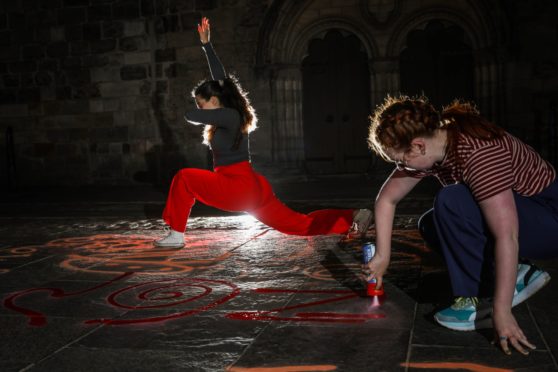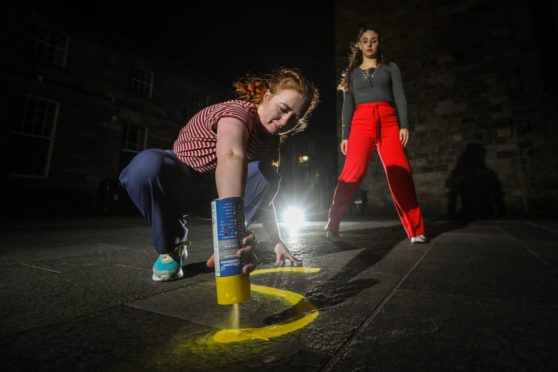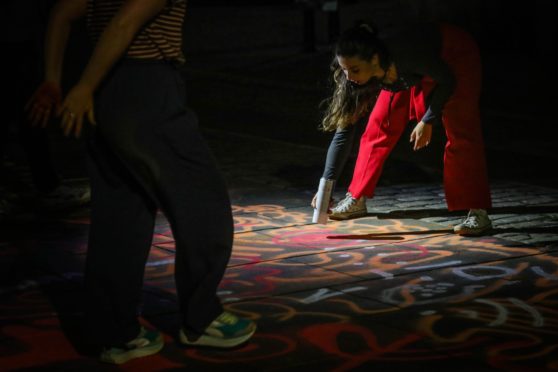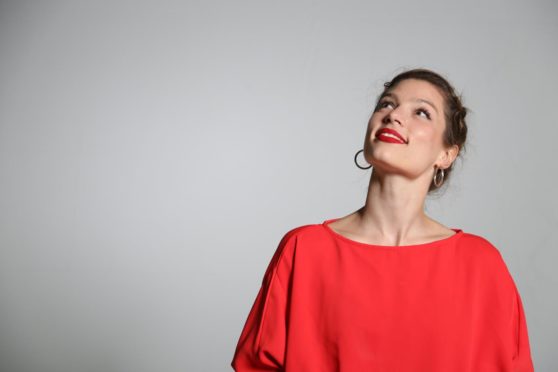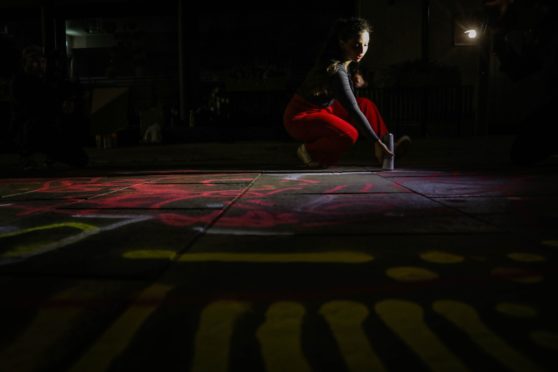St Andrews residents waking up to colourful patterns on the ground today may “chalk” them up to magic – or mischief.
But the truth behind these elaborate chalk designs is a bit of both.
Invisible Dances, a secret arts piece performed under the cover of night, has been to St Andrews – and left its (temporary) traces behind, in the hope that they will inspire, or at least intrigue, passers-by.
The dance project, which has been performed in more than 50 cities in 14 countries worldwide, was conceived by German dancer and choreographer Elisabeth Schilling as a way of bringing art into communities safely during the pandemic.
And she is delighted to have brought it to Scotland’s ancient city of St Andrews, in partnership with the Byre Theatre and funded by Creative Scotland.
Representatives from the theatre will even be on hand today, along with the dancers, to chat to locals about their response.
“The Invisible Dances started as a tiny, tiny idea,” Elisabeth explains. “It was born in the first lockdown, because I saw my friends get sadder and sadder that everything was cancelled.
“So I came up with this idea of performing during the night, in order to avoid assemblies of people. And the performance would be unannounced so that nobody could come and watch, to keep it safe.”
Dancing in the dark
Performing at night was a clever solution to lockdown restrictions.
But to paraphrase that riddle about the tree and the forest: If a dancer dances in the middle of the street and there’s no one around to see it, are they really performing?
For Elisabeth, this is where the chalk “traces” come in.
She explains’: “I was thinking: ‘If nobody can watch us, what can be the way the dance can still be experienced by an audience?’
“And so the dance is visualised by so-called ‘tracers’ with chalk spray.”
But locals needn’t be worries – the chalk spray is environmentally friendly and biodegradable, and washes away again with the next rain. So the “exhibition” is temporary – especially knowing Scottish weather.
“The next morning, when the people wake up, and they walk to work, or go to school or the kindergarten, they hopefully stumble upon those traces,” continues Elisabeth.
“The team invites people to walk on the traces, to dance their own Invisible Dance on them; to draw the lines at home or even to take pictures and send them back to me!”
Staying local and going green
For Elisabeth, a huge part of what makes Invisible Dances special is the community aspect in each location. She hires local dancers for each city, and partners closely with organisations in every place.
Niamh O’Loughlin, who was part of the St Andrews show along with Antonia Hamilton, says: “Invisible Dances is a chance for us to remind St Andrews that we’re still here, still dancing and always evolving.
“We’re all very excited to get away from the Zoom screen and back into the real world. And to look at our surroundings as inspiration; to turn our heads rather than look directly at a screen.”
And the local component is not just because of Covid restrictions.
Elisabeth also believes there is an environmental factor to be considered with travelling arts like dance.
“We really try to employ local people and to reduce the travel as much as we can,” she explains. “Of course because of Covid, but also because of climate change.
“And I believe that in terms of touring, we have a responsibility to think of new ways to bring international art to all kinds of places while reducing travel.”
‘It might look like graffiti – it is not!’
Impressively, for a global project in a digital age, none of the performances have been leaked ahead of time, making the Invisible Dances an incredibly well-kept secret.
The idea has been largely well-received around the world, although Elisabeth, who has been managing the whole project from her base in Germany, admits some people get the wrong impression at first glance.
“Sometimes people think it’s vandalism, because at a first glimpse it might look like graffiti – which of course it is not!” she laughs.
“It is a dance piece, but it’s a very unusual dance piece, just due to the time we’ve been living through. Which, I suppose, demanded for unusual art.
“So it definitely raises questions.”
Poem lends a Scottish twist
To help answer those questions, Elisabeth and her team have developed a sign which goes up at the site of the traces, explaining the project.
The sign, which is present at every performance, also entertains readers with a short poem, written by Scottish artist Róisín O’Brien.
“Róisín is an amazing writer and she’s a dancer as well, so she was keen to collaborate on this,” remarks Elisabeth.
“She’s a Scottish writer, and I think she’s as excited as I am that it’s coming back to her home country.”
After 55 performances in 14 countries around the globe and 200 participants involved to date, we are excited to publish the upcoming Scotland tour of the Invisible Dances. Funded by @creativescots and in partnership with 10 arts venues & institutions… pic.twitter.com/YcXQzTIRta
— Elisabeth Schilling (@ElisaSchilling) August 8, 2021
Róisín added: “I think when we’re in something as all-consuming as global pandemic, it’s hard to recognise the specifics of our situation.
“I tried in the poem to capture something of the environment we were all living in – the constant blue flashes of ambulances, the quiet streets partly reclaimed by nature – that maybe felt ‘obvious’ to say at the time, but in retrospect we’ll be glad we have these recordings of this difficult time.”
‘Spontaneous’ treat for St Andrews fans
As well as the sign, today only, St Andrews audiences will be treated today to a so-called Spontaneous Encounter, where the performers will be on site to discuss and answer questions about the project.
Jan McTaggart, deputy director at the town’s Byre Theatre, was present at the nighttime performance and will also be in attendance.
She welcomes people to come along and chat about the project, saying: “I find the thought of this hidden, secret performance that leaves colourful traces behind it, quite thrilling. Why else would I be out in the streets at a ridiculous time of night?
“I’m curious about the response too. I’d love to see people trying to dance along the traces, and I know that some people will have questions.
“After a long 18 months where we couldn’t engage with audiences in person, I’m looking forward to hearing what people have to say.”
Dancer Antonia is also excited to meet people at the site of the traces.
“It is exciting to finally be getting art back out there after a tough 18 months following the start of the pandemic,” she says.
“I’m looking forward to getting the local community and visiting tourists involved, with what is now a global project.
“It’ll be great to see how people interact and imagine myself and Niamh moving.”
The St Andrews “Spontaneous Encounters” will take place today from 10am on Logies Lane, outside Holy Trinity Church.
Find out more about the Invisible Dances on the project’s website.
